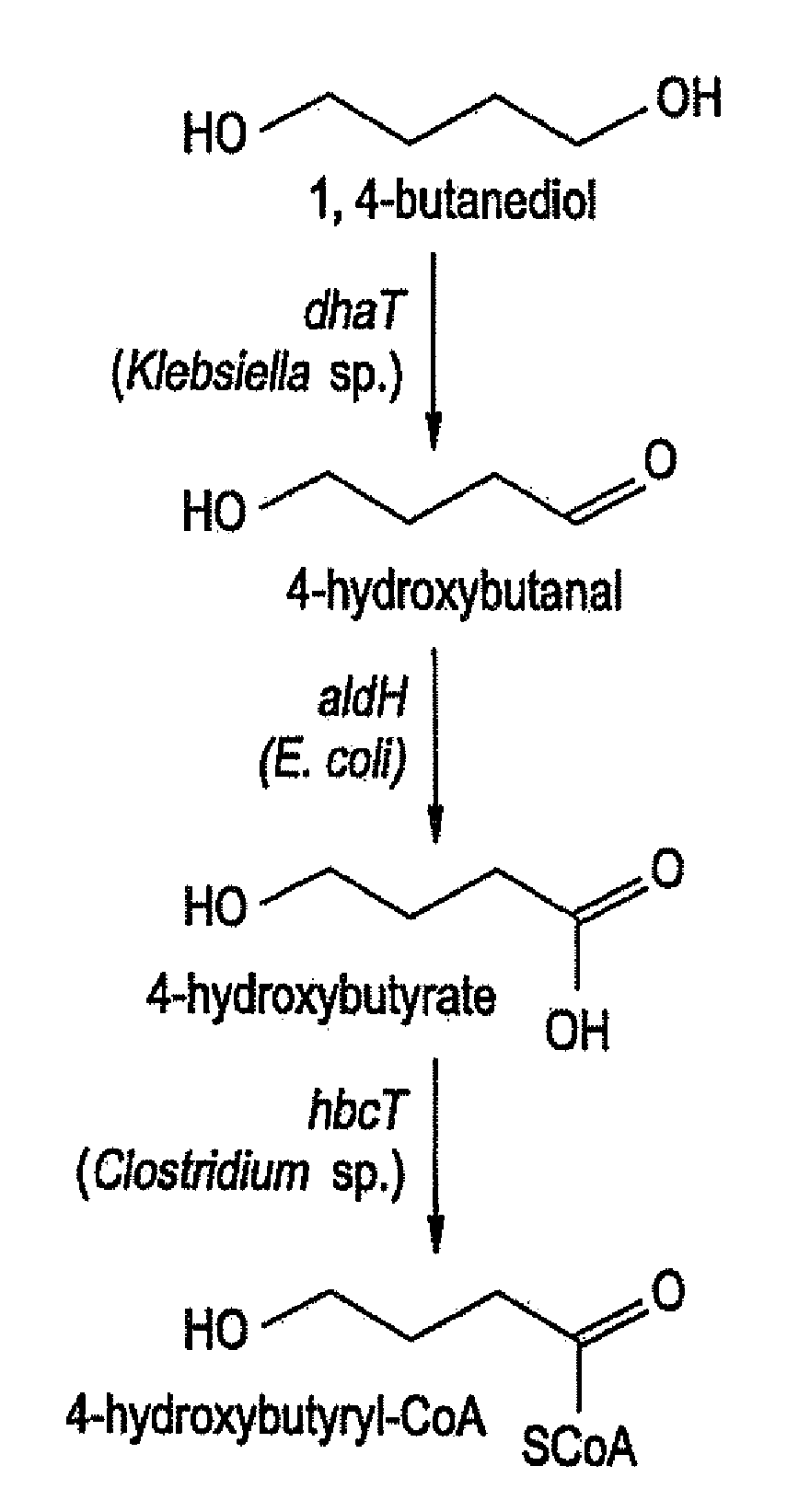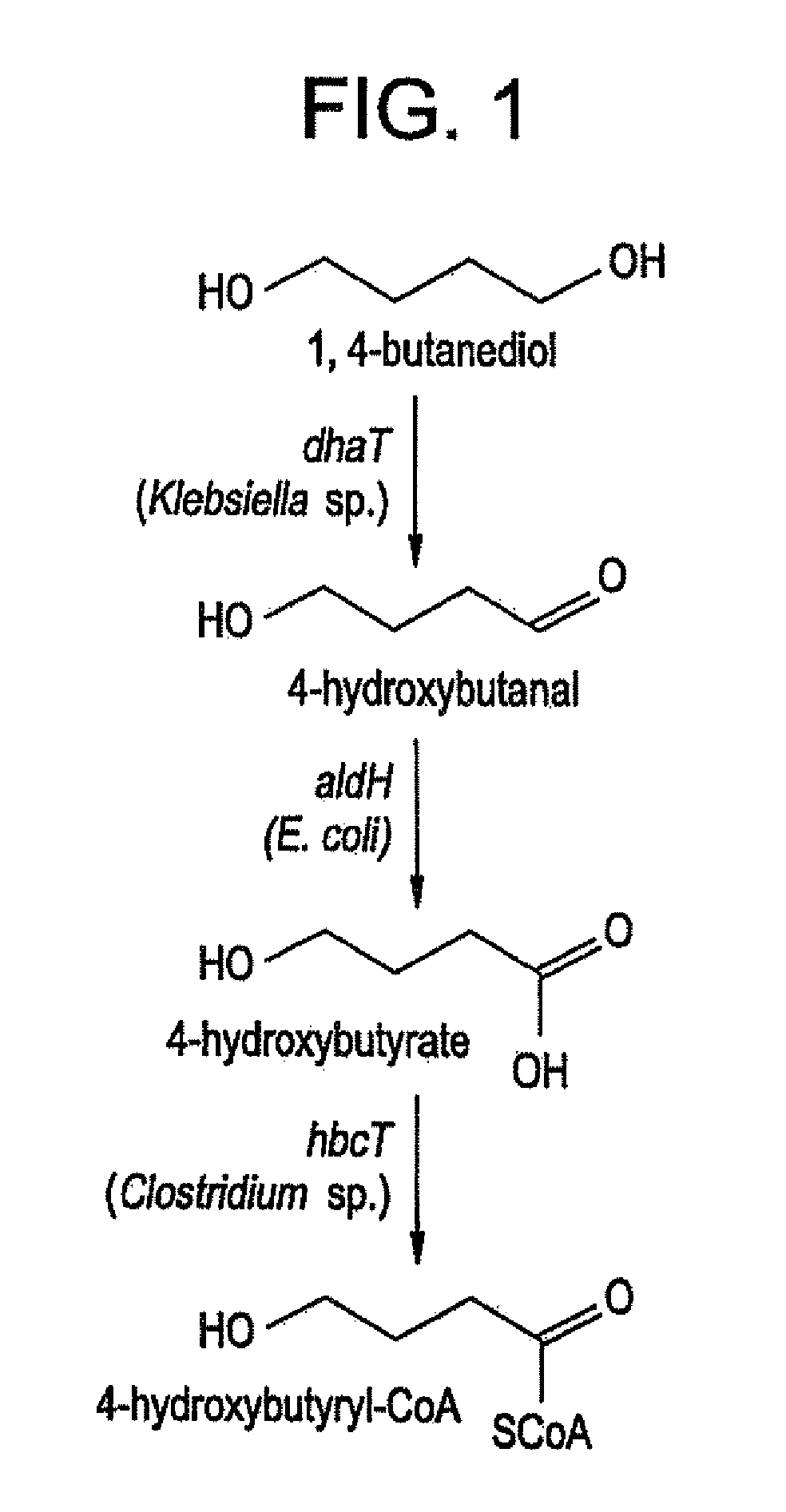Production of Polyhydroxyalkanoates From Polyols
a technology of polyols and alkanoates, applied in biochemistry apparatus and processes, microorganisms, organic chemistry, etc., can solve the problems of low growth rate, difficult to break open, limited amenity to genetic engineering, etc., and achieve the effect of improving the production of pha homopolymers and being readily recovered
- Summary
- Abstract
- Description
- Claims
- Application Information
AI Technical Summary
Benefits of technology
Problems solved by technology
Method used
Image
Examples
example 1
Enzymatic Assay of Escherichia coli AldH
[0031]On the basis of its homology with other aldehyde dehydrogenases, the aldH gene was cloned by PCR from the E. coli genome. Plasmid pMS33 contains aldH under the control of the trc promoter. E. coli DH 5α was transformed with pMS33 or pFS14, as a negative control. Plasmid pFS14 contains the Clostridium kluyveri 4hbD (4HB dehydrogenase) gene, as described in Söhling and Gottschalk (1996, J. Bacteriol. 178:871-80).
[0032]DH5α / pMS33 and DH5α / pFS14 were grown at 37° C. with shaking in Luria-Bertani (LB; Difco; Detroit, Mich.) broth to an optical density (600 nm) of 0.5 and subsequently induced with 1 mM isopropyl-β-D-thiogalactopyranoside (IPTG). The incubation continued for 3 hours, after which the cells were removed from the medium by centrifugation (2000 g, 10 min.), washed in 0.1 M Tris (pH 8.0), centrifuged again, and resuspended in a volume of 0.1 M Tris (pH 8.0) roughly equal to the size of the cell pellet. Each sample was sonicated (XL ...
example 2
Growth of E. coli with 1,4-Butanediol as Sole Carbon Source
[0038]E. coli strain LS5218 (obtained from the Yale E. coli Genetic Stock Center, New Haven, Conn., as strain CGSC 6966) was transformed with either of two plasmids, pFS76 or pFS77. pFS76 contains the 4HB dehydrogenase (gbd) gene from Ralstonia eutropha, as described in Valentin et al. (1995, Eur. J. Biochem. 227:43-60). Plasmid pFS77 contains the gbd gene as well as the E. coli aldehyde dehydrogenase (aldH) gene and the Klebsiella pneumoniae 1,3-propanediol oxidoreductase (dhaT) gene, arranged in a single operon. Both plasmids contain the trc promoter for transcription of the genes.
[0039]LS5218 / pFS76 and LS5218 / pFS77 were streaked onto minimal-medium plates containing 5 g / L of either 4HB (4-hydroxybutyrate, as the sodium salt) or 1,4-butanediol. The plate medium also contained, per liter: 15 g agar; 1 mmol MgSO4; 10 mg thiamine; 25.5 mmol Na2HPO4; 33.3 mmol K2HPO4; 27.2 mmol KH2PO4; 2.78 mg FeSO4.7H2O; 1.98 mg MnCl2.4H2O; 2...
example 3
Production of Poly(4HB) From 1,4-Butanediol
[0044]Escherichia colt strain LS5218 (CGSC 6966) was transformed with either of two plasmids, pFS30 or pMS60. pFS30 contains the Ralstonia eutropha PRA synthase (phaC) gene and the Clostridium kluyveri 4HB—CoA transferase (hbcT) gene, both under control of the trc promoter. pMS60 contains the aldH and dhaT genes along with the two genes in pFS30, all under control of the trc promoter. The objective of the experiment was to determine whether the addition of the aldH and dhaT genes would be beneficial to the conversion of 1,4-butanediol to 4HB in the PHA polymer.
[0045]Each strain was grown in LB broth supplemented with 100 g / mL ampicillin overnight at 37° C. with shaking at 250 rpm. The cells were then removed from the medium by centrifugation (2000 g, 10 min.) and resuspended in 100 mL of a medium containing, per liter: 2.5 g LB powder; 50 mmol potassium phosphate, pH 7.0; 2 g glucose; 5 g 1,4-butanediol; 100 μg ampicillin; and 0.1 mmol IPTG...
PUM
| Property | Measurement | Unit |
|---|---|---|
| elongation to break | aaaaa | aaaaa |
| Tm | aaaaa | aaaaa |
| optical density | aaaaa | aaaaa |
Abstract
Description
Claims
Application Information
 Login to View More
Login to View More - R&D
- Intellectual Property
- Life Sciences
- Materials
- Tech Scout
- Unparalleled Data Quality
- Higher Quality Content
- 60% Fewer Hallucinations
Browse by: Latest US Patents, China's latest patents, Technical Efficacy Thesaurus, Application Domain, Technology Topic, Popular Technical Reports.
© 2025 PatSnap. All rights reserved.Legal|Privacy policy|Modern Slavery Act Transparency Statement|Sitemap|About US| Contact US: help@patsnap.com


